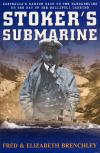Lost Subs
From the Hunley to Kursk
Dunmore, Spencer
2009, Madison Press Books
ISBN 1897330413
Paperback, 176 pages
| Type. | Coffee-table compilation of famous submarine losses |
| Pros. | Brilliant graphics and photographs lavishly illustrate story |
| Cons. | Focus on disaster and tragedy detrimental to history of operations |
| Rating. |  |
 This excellent new book gives a broad, effective look at the history of submarining, viewed through some of its most infamous disasters from CSS Hunley in 1863, AE-2 off Turkey, HMS Thetis and USS Squalus, USS Thresher and Scorpion, all the way to the clandestine tragedy and suspicious accusations surrounding Kursk, in August 2000. It has the most up to date accounts of the losses and theories about Kursk, Resurgam, Hunley and their raising and restoration; declassified pictures of Scorpion and Thresher, the other things Ballard was looking in the North Atlantic for in 1985, besides Titanic...
This excellent new book gives a broad, effective look at the history of submarining, viewed through some of its most infamous disasters from CSS Hunley in 1863, AE-2 off Turkey, HMS Thetis and USS Squalus, USS Thresher and Scorpion, all the way to the clandestine tragedy and suspicious accusations surrounding Kursk, in August 2000. It has the most up to date accounts of the losses and theories about Kursk, Resurgam, Hunley and their raising and restoration; declassified pictures of Scorpion and Thresher, the other things Ballard was looking in the North Atlantic for in 1985, besides Titanic...
In a book for the general public, submarine technology and operations are somewhat buried by the focus on losses - a book emphasising the men and sea and the struggle and drama, not a cold, careful account of these losses amid the history of submarine development and deployment. Nevertheless how submersibles work and why they were used, and the turning points - Holland, Lusitania, the Atlantic campaigns, Nuclear power - are smoothly blended among the punctuations the famous losses make in each period.
It is also lavishly illustrated with period and modern artwork, posters, diagrammes, many unpublished photos of all the vessels featured, in service, on the bottom, as well as those raised. It is in the vein of Wolfpack and Convoy by Kaplan & Currie [Aurum Press, London, 1997-98]. Its coverage thus goes well beyond merely staid postcard and official images of these submarines, into the times and context of the events. Brilliant graphics fill in the blanks for a non-specialist audience, for this is intended as a general book for the public, as well as the fans and buffs. How an escape trunk works, how Kursk was found, explored, cut up and raised, are magnificently depicted, if a little too briefly.
To this end more explanation of how submarines work, and how their technology interacts might have been an advantage. This is not Submarines for Dummies, and its focus is on the men and the drama, not the machines. Much explanation of how submarines work and why they sink is left too late, among the final chapters, when the book might have been better served by placing it first. Beyond the introduction of nuclear reactors, little has changed in terms of submarine principles since the earliest days.
Nevertheless this is an excellent work, with effective coverage and explanation of submarine technology, operations, how they changed warfare, and how they were employed and lost. The men and the dangers are at the forfront, which is how you capture and hold the public’s interrest, and how you focus more experienced and informed readers. Its imaging and illustrations go a long way to dispelling confusion and aiding comprehension for specialists and novices alike. Anyone, general public, naval buff, or professional researcher, will have much to gain from this book.
The reviewer welcomes your comments on this review.
Review written by Ian Campbell, Launceston, Tasmania.
Published on 5 Aug 2003.
This title is highly recommended.
Return to our main review page.



